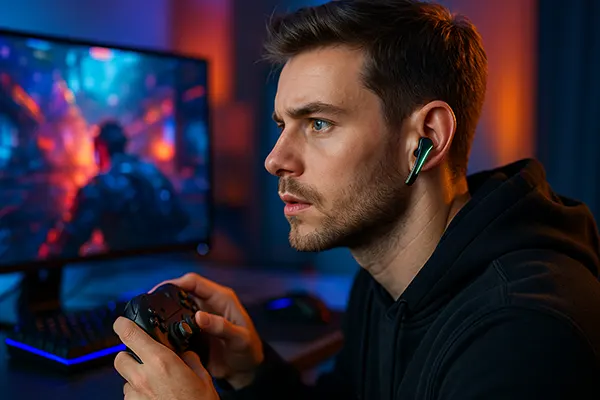
Earable: The Future of ‘Smart Ears’ — How Headphones Are Turning into Multifunctional Devices for Gamers
In 2025, wearable technology has evolved far beyond fitness trackers and smartwatches. A new generation of intelligent earwear — known as Earables — is reshaping the way people play, communicate, and experience virtual environments. Designed to enhance sound, performance, and comfort, these smart devices are becoming an essential tool for gamers seeking immersion and precision.
The Rise of Earable Technology
The term “Earable” refers to a class of intelligent ear devices that combine audio engineering, biometric sensors, and artificial intelligence. Unlike traditional headphones, these gadgets track vital data such as heart rate, stress levels, or brain activity, providing users with feedback in real time. For gamers, this means a new level of connection between body and gameplay.
Major technology companies like Bose, Sony, and startups such as Earable Inc. have introduced prototypes capable of detecting concentration patterns through EEG sensors. This data allows systems to adapt sound intensity or environmental awareness dynamically. In multiplayer games, these features help maintain alertness and improve decision-making speed.
By integrating voice recognition and low-latency Bluetooth 5.4 connectivity, Earables have become powerful extensions of gaming consoles and PCs. They offer intuitive voice commands, personalised audio calibration, and longer battery life — features that make them more than just a pair of headphones.
How Earables Are Changing Gaming Interaction
For professional gamers and eSports enthusiasts, every millisecond counts. Earables can now analyse reaction time and adjust in-game sound cues accordingly. For instance, if a player’s stress level rises, adaptive soundscapes can reduce auditory clutter, keeping focus intact. This level of responsiveness is a direct result of integrating AI-driven acoustic mapping.
Furthermore, real-time biometric monitoring allows players to identify patterns of fatigue or stress during tournaments. Developers are already designing APIs that connect this data with game engines, offering personalised experiences that evolve with the player’s condition. Such innovation is bridging the gap between physiology and performance.
In social gaming environments, Earables also enable more natural communication. With advanced beamforming microphones and noise suppression, gamers can coordinate efficiently without being distracted by background sounds. This transforms team-based strategies and strengthens collaboration during intense matches.
AI Integration and Adaptive Audio
Artificial intelligence is at the heart of every next-generation Earable. In 2025, these devices use embedded machine learning models to predict user preferences and emotional states. For gamers, that means automatic adjustment of sound profiles based on the genre, volume sensitivity, or environmental noise levels. This smart adaptation ensures the ideal balance between immersion and comfort.
Another major advancement is spatial awareness. Modern Earables can map the gaming environment and adjust audio direction in real time, simulating 3D sound positioning without the need for external head-tracking hardware. This technology has become a game-changer for VR titles and simulation games that rely heavily on spatial accuracy.
AI also assists in personalising sound signatures. Using data collected from individual ear shapes and hearing patterns, Earables can tune frequencies uniquely for each user. This level of audio customisation was previously accessible only in professional studios, but by 2025 it has become mainstream for advanced gaming headsets.
Health, Safety, and Cognitive Benefits
While designed for entertainment, Earables also contribute to user health and well-being. By monitoring oxygen saturation and pulse, they can alert players to take breaks, hydrate, or adjust posture. This proactive approach prevents strain and improves long-term concentration, making gaming safer and more sustainable.
Some models even feature neurofeedback capabilities, helping users train focus through guided breathing or relaxation cues. These elements, combined with immersive soundscapes, create a form of mental conditioning that supports better in-game performance and cognitive control. It’s a synergy between neuroscience and entertainment technology.
Beyond gaming, Earables have found a role in everyday productivity. Many users apply them for mindfulness sessions, remote meetings, and real-world navigation. Their seamless integration into daily life shows how gaming innovations often lead to broader lifestyle technologies.

The Future of Earables in Competitive and Casual Gaming
As the gaming industry continues to grow, Earables are expected to become a standard accessory. Manufacturers are investing in cloud-based ecosystems that sync user data, achievements, and biometric profiles across devices. This integration will allow players to maintain consistent performance analytics, whether they are gaming on a PC, console, or mobile device.
In eSports, coaches may soon use Earable data to evaluate player endurance, concentration, and mental resilience. Such insights could revolutionise training methods and redefine competitive standards. By merging biology with digital analytics, the line between the player and the game will continue to blur.
For casual users, affordability and accessibility will drive adoption. As production costs decrease and battery efficiency improves, Earables will reach mainstream popularity. The trend points to a future where personalised sound, health tracking, and adaptive intelligence converge in a single lightweight device.
What Lies Ahead for Gamers and Developers
By 2030, Earables are projected to become an integral part of mixed reality systems. Developers are already exploring integration with eye-tracking and haptic feedback technologies to create unified sensory environments. These innovations will redefine immersion beyond what current headsets can offer.
In the short term, cross-platform compatibility and privacy protection remain key challenges. As Earables collect sensitive health data, manufacturers must prioritise encryption and transparent data use policies. Building user trust will determine how rapidly this technology evolves and how widely it’s adopted.
Ultimately, Earables represent a natural step forward in the fusion of human perception and technology. For gamers, they mark the beginning of an era where sound, data, and emotion operate in perfect harmony — transforming not only how games are played, but how they are felt.


